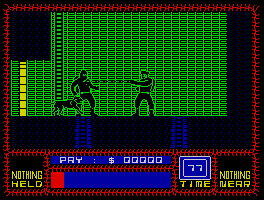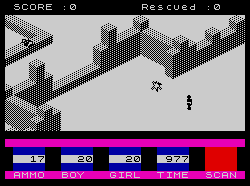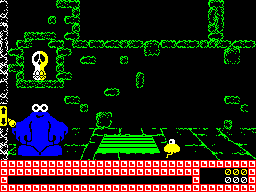
ARCADE ADVENTURES
The top five Spectrum arcade adventures, the best of the rest, and a brief history of the genre.

1. ATIC ATAC
(Ultimate - 1983)
This was more or less the game the term 'arcade adventure' was coined for, and one that spent many months at the top of the charts in the computer press. It is set in a castle of 200 rooms and hidden among those chambers are the three parts of a key needed to escape. You can take the role of a knight, a wizard or a serf in your quest, each having different weapons and being able to use different secret passages. After a few seconds in each room, a variety of baddies materialise, who drain your energy on contact. Despite the clumsy controls, Atic Atac is a genre-defining game, and one of the iconic Spectrum titles.

2. EVERYONE'S A WALLY
(Mikrogen - 1985)
After Automania and Pyjamarama came this excellent follow-up. In the first two games you played the part of Wally Week, but Everyone's a Wally introduced a host of new characters for you to control. The aim is to rob a bank by collecting code letters that make up the safe combination. The letters are represented by objects that need to be taken to the bank in the correct order. To complicate matters, each character has a task which must be completed using the right tools, while avoiding hazards that drain their energy. A large, well-designed and involving game.

3. FRED
(Quicksilva - 1984)
In essence, Fred is an old fashioned maze game, but one with enough original twists to set it apart from similar titles. You guide an intrepid archaeologist through the passages of an Egyptain tomb, gathering as much loot as you can before escaping. Fred is armed with a pistol to defend himself against the ghosts, mummies and other nasties that roam the ancient passages, but bullets are in short supply, so must be used sparingly. The graphics are big, smooth and cartoonish, and the game is easy and fun to play. Quicksilva published Fred under licence from Spanish software house Indescomp.

4. THE GREAT ESCAPE
(Ocean - 1986)
The Great Escape only just scraped into the Golden Years, being released at Christmas 1986. It's fortunate it did though, because this was a terrific title that stood out of from a crowd of isometric games. It is set in a German POW camp, and like any patriotic Tommy you consider it your duty to make your escape. You can tunnel your way out, snip through the fence or use bribery, but be careful not to miss any of the daily duties or the Hun will be onto you before you can say Steve McQueen. If you're rumbled, your morale plummets and will need boosting again by collecting objects crucial to your escape.

5. SABOTEUR
(Durell - 1986)
In Saboteur you play a ninja warrior on a mission to infiltrate a security building and escape with a computer disk. The building is a maze of platforms and ladders, but instead of an irate gorilla at the top, hurling barrels at you, there's a team of security guards trained in martial arts for you to contend with. Fortunately, you're a dab hand with the high kicks yourself, although you can avoid scuffing your shoes by using weapons you find around the complex: knives, throwing stars, pipes, pieces of wood, even bricks. The graphics are large and clear, and the action becomes increasingly frantic as you progress.
Despite the game's revolutionary graphics, it's tricky to control and its appeal isn't lasting, but it is rightly remembered as a landmark title.
Avalon (Hewson - 1984)
Avalon claimed to be the first 'adventure movie' and, if so, it paved the way for today's RPG video games. You control the astral projection of Maroc the Wizard (presumably the man himself is at home with his feet up). You must explore the passages and dungeons of the Avalon castle, and destroy the Lord of Chaos, learning spells along the way to aid your quest. These spells are at the heart of the game and allow you to do things like freeze time and become invisible. The graphics are erratic at times, but the game's strength is its role-playing elements and its engrossing gameplay. An even better sequel, Dragtorc, followed.
Fairlight (The Edge - 1986)
Despite the proliferation of isometric 3D games that followed in the wake of Ultimate's Knight Lore, Fairlight still managed to impress. As Isvar, you find yourself trapped in a castle and must escape by finding the Book of Light and taking it to the sorcerer. There are guards and beasties roaming the castle that can be slain using Isvar's sword, but some are probably best avoided. Unlike earlier 3D efforts, objects behave according to the laws of physics, as opposed to being immovable decoration. This is a large and brain-teasing game that was followed by an equally fine sequel.
Frankie Goes to Hollywood (Ocean-1985)
Proving that not all spin-offs were naff, Denton Designs brought together culture, politics, existentialism and social commentary in this beguiling arcade adventure. On your surreal quest to reach the Pleasuredome and make 'real' your empty husk of a character, you encounter puzzles and mini games, all presented with Denton's usual graphical finesse. A remarkable, imaginative game.
Ghostbusters (Activision - 1985)
There's no escaping that this isn't a great game, but it deserves a mention for the sheer amount of attention it garnered on its release. Already a hit on the Commodore 64 by the time it reached the Spectrum, Ghostbusters promised a lot and delivered little. The superb music on the C64 version never showed up on the Spectrum - in fact there's scarcely any sound at all - and the graphics are merely passable. There are arcade and strategy elements to the game, but it's all rather ponderous and there's not much to hold the interest for long. Still, it sold like hot cakes and set the tone for heavily-advertised tie-ins that would loom large from 1985 onward.
Halls of the Things (Crystal - 1983)
The game is set in a maze-like series of rooms, stairwells and corridors, which your character explores in search of a number of magic rings. Evil creatures stand in your way, hurling lightning and fireballs at you, but you have weapons of your own to combat them with, and should you lose too much health, you can repair the damage using your limited store of magic. Hall of the Things looks rudimentary compared to the likes of Atic Atac, but it was one of the few arcade adventures on the market for a while, and may even have been the first of its kind.
Jack the Nipper (Gremlin - 1986)
Pranks, japes and general naughtiness are the order of the day in this breezy effort from Gremlin. Steer toddler Jack around town, wreaking as much havoc as possible and boosting your 'Naughtyometer' rating. Smashing plates, scaring cats and menacing people with your peashooter are just some of the evil deeds you get up to, and it all looks good, thanks to the cartoonish graphics.
The term 'arcade adventure' first appeared in the early 1980s to describe games such as Atic Atac, but soon people were applying it to any arcade game that required a little thought or exploration. This led to Jet Set Willy being described as such when it clearly belongs in the platform genre.
Used here, arcade adventure describes those games that combine the arcade element of guiding an on-screen character about a multi-screen environment, with adventure-like puzzle solving. This definition is bound to cause confusion and disagreement, but it is difficult to brand the likes of Sabre Wulf as a straight-up arcade game without doing the same for platformers and shoot 'em ups. Some leeway is required to keep gaming categories from losing all meaning.
The lengthier gaming sessions afforded by home computers allowed players a more involving experience. Games could afford to be more complex and involving than their arcade forebears, which were principally concerned with coin-munching action. Arcade adventures were born out of the new technology and how it was used.
Sinclair User used the term 'arcade strategy' to describe this type of game in its June 1984 issue, shortly before 'adventure' replaced 'strategy' in common usage. It wrote:
"Games manufacturers with an eagle eye on the industry saw that the time would arrive when arcade games such as Space Invaders and Centipede would fade in popularity, and that something had to be added to make them more appealing.
The one aspect which games such as those already had was strategy. In games such as Space Invaders, strategy is needed to evade the aliens and at the same time fire at them. A good game will infer a strategy to the player and a good player is one who can assimilate that method of play quickly.
To succeed, arcade-strategy games must produce an effect for the player like that produced by an ordinary zap-em game. It is the way the addiction is created which makes the difference. In an ordinary arcade game the effect is created through a need to destroy aliens and make a high score. Arcade-strategy games are different, as they rely on the user's mind. It is the strategy as well as the graphics which keeps the player returning for more.
The combination of arcade techniques and strategic thinking has made the arcade-strategy game very popular. The insurgence of that type of program means that the customer has two types of game in one and the reality of the plot, through the realism of the arcade graphics, takes the games industry one step forward."

The best of the rest
Ant Attack (Quicksilva - 1984)
When author Sandy White, a sculptor by trade, sent Ant Attack to Quicksilva for consideration, they were so amazed by its 3D graphics they immediately flew him down from Scotland to sign a contract. Somewhere within a city swarming with giant ants, your other half (you can as play a boy or a girl) is trapped and needs rescuing. To defend yourself, you can either jump on the ants to stun them, or blast them with your hand grenades.
Kokotoni Wilf (Elite - 1984)
Having changed its name from Richard Wilcox Software, Elite's first title was this unusual arcade adventure. As Wilf, your task is to collect 63 parts of a dragon amulet scattered through time. You must travel through historical periods to locate the parts, avoiding the likes of dinosaurs in prehistoric times and warriors from the Middle Ages. Quaintly enough, 2001 is represented by a futuristic space age. How distant the new millennium must have seemed in 1984.
Max Headroom (Quicksilva - 1986)
Based on the Channel 4 movie, Max Headroom is essentially an against-the-clock code-breaking game connected by arcade elements. You control a reporter (aided by his trusty assistant) out to recover Max from the sinister Network 23, by penetrating the numerous layers of security in its headquarters building. Between hacking episodes, you have to contend with guards, armed assassins and security robots, out to stop you. The graphics are crude, but the code-breaking puzzles are gnarly and the playing area vast.
Skool Daze (Microsphere - 1985)
As Eric the schoolboy you must snatch your end-of-term report from the headmaster's safe to prevent your parents from discovering the true horror of its contents. This involves shooting the shields on the school walls with your catapult, then knocking over teachers to extract combination codes from them - all except the history master, who's had his code letter implanted in his brain by hypnosis. Great fun (although it was probably a bit of a busman's holiday for most players), there was enjoyment to be had just watching all the characters going about their business. The sequel Back to Skool was arguably better still.
Sabre Wulf (Ultimate - 1984)
This section would not be complete without mentioning the most successful Spectrum title of them all. In essence, Sabre Wulf is a maze game, but one with beautifully colourful graphics and enough clever features to distinguish it from the crowd. The premise is similar to Atic Atac's: find the four parts of an amulet and make your escape. Snakes, scorpions and natives are just some of the foes that hound Sabreman from start to finish, but he has his trusty sword with which to see them off. Its enormous success goes to show that, however many games used similar ideas, Ultimate usually did it best.
Spy vs Spy (Melbourne - 1985)
MAD magazine's feuding spies had already proved a hit on the Commodore 64 before they arrived on the Spectrum, and little was lost in translation. Utilising a split-screen, your spy has to search a foreign embassy for five items and make his escape before his opponent. You can set booby traps to foil the other spy, like buckets of water over doors, but as the rooms all look similar it's easy to walk into your own traps. One-player mode is fun enough, but going head-to-head against another player takes the game to another level.
That's the Spirit (The Edge - 1985)
In the far-off year of 1996, when all the cities of the world have been renamed New York, supernatural spooks have been outlawed, and it's your job to hunt them down. Not that this will be easy - not with nearly 30 different keypress instructions to master, anyway. Getting to the point of busting ghosts requires you to gather items about the playing area and put them to good use. The graphics are a bit hokey, and the controls take some getting used to (the original came with a handy cut-out keyboard overlay), but there's plenty to do in this light-hearted romp, what with combining objects to solve problems, and keeping your fatigue and sanity levels in check.
Tir Na Nog (Gargoyle - 1984)
You control the hero Cuchulainn in his quest through the Celtic afterworld. Despite it's glorious sideways-scrolling graphics, this is far more adventure than arcade, with numerous puzzles to solve in your search for the fragments of the Seal of Calum. You encounter other characters fixing for a fight, but as you are already in the afterworld you cannot die - defeat simply takes you back to the beginning. The playing environment is vast, detailed and chock full of atmosphere, making Tir Na Nog a strikingly original game. Gargolye produced a sequel Dun Darach, and a futuristic variant called Marsport, all using the same basic design.
The Trap Door (Piranha - 1986)
Veteran Spectrum programmer Don Priestley dabbled in everything from strategies (Dictator, Minder) to shoot 'em ups (Meteoroid, 3D Tanx), but he struck gold with this lighthearted arcade adventure based on the popular kids' TV show. As Berk, the bulbous lackey of 'The Thing Upstairs', you must complete a series of chores, making use of items scattered about your castle and interacting with the various creatures that emerge from the trap door - some of which are a serious hindrance or a threat to your health. The big, cartoonish graphics are a delight, which cleverly avoid the Spectrum's infamous attribute-clash, and the game was popular enough to spawn a sequel: Through the Trap Door.

Underwurlde (Ultimate - 1984)
Despite being released alongside Knight Lore at Christmas 1984, Underwurlde was in no way inferior to its 3D sibling. It marked the return of Sabreman in a mammoth game that represented a notable development on Atic Atac and Sabrewulf. It is set in a complex of caverns, rooms and passageways from which you must escape. The creatures that materialise around you don't cause any direct harm, but hinder your movement and force you into costly errors. It was slightly overshadowed by Knight Lore at the time of its release, but is actually the more involving title.
Wriggler (Romantic Robot - 1985)
Romantic Robot was a company more associated with hardware than games, but its first release was a fine effort. At the beginning, it looks as though you are about to take part in a race. Four maggots line up and an ant fires a starting pistol, but three of the maggots speed off to become your extra lives and you find yourself at the start of a maze. As well as winding your way towards the exit, you need to keep your maggot's energy up by feasting on snacks that litter the trail, and overcome obstacles with the help of special objects. Essentially an old-fashioned maze game, Wriggler has enough strategic elements to separate it from standard arcade fare.